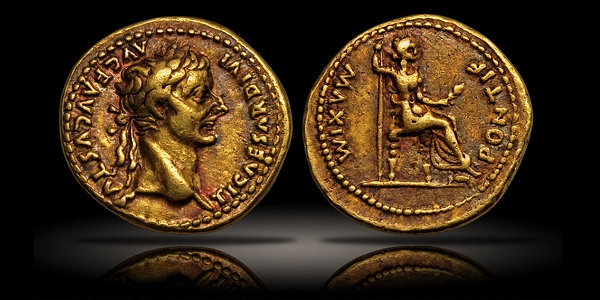Tribute Penny – Tiberius (14-37 CE). AV aureus ). Lugdunum, ca. 18-35 CE.
The same type was also issued in silver, which became known as the “Tribute Penny” due to its famous reference in the Bible
By Russell A. Augustin, AU Capital Management, LLC ……
Providing significant contrast to the many people who would eventually die fighting for their spot as emperor of Rome, Tiberius didn’t particularly want the title. He was Augustus’ stepson and became emperor in 14 CE upon Augustus’ death. He made many positive contributions as one of the greatest Roman generals, conquering vast lands and increasing the Empire’s treasury to nearly three billion sestertii. However, he quickly decided to distance himself from the day-to-day workings of Rome. He progressively gave power to the Praetorian Prefect Sejanus, which proved to be very unwise as Sejanus proceeded to arrest and murder most of the Julio-Claudian family behind Tiberius’ back.
Frustrated with the subterfuge and politics that came along with the position, Tiberius left Rome to retire on the island of Capri in 27 CE, effectively giving Sejanus free reign over the Empire. However, after being suspected of conspiring against Tiberius, Sejanus was imprisoned and executed. When Tiberius eventually died, the succession was left to his nephew Caligula and grandson Tiberius Gemellus. Caligula quickly began establishing his reputation as one of the most hated and evil of all Roman emperors by nullifying Tiberius’ will and executing Gemellus, becoming sole emperor.
Most emperors cared deeply about their coinage and would issue a vast range of designs, reflecting current events and progress made within the Empire. Tiberius took the opposite approach, leaving a single precious metal type in place for nearly the entirety of his 23-year reign. Furthermore, the type itself was a duplicate from one of Augustus’ late emissions, indicating just how little focus Tiberius placed on his coinage.
This type proved to be one of the most widely used coinages in Roman history and ranks among the most familiar coins of antiquity. They circulated throughout the Empire and as far as India, with evidence that many pieces were used into the second century CE.
The reverse inscription of PONTIF MAXIM references Tiberius’ status as the head of the Roman state religion. The image on the reverse is generally interpreted as his mother Livia, seated and holding a laurel branch, representing Pax, the personification of peace.
The same type was also issued in silver, which became known as the “Tribute Penny” due to its famous reference in The Bible as the coin Jesus discussed to “render unto Caesar the things that are Caesar’s, and to God the things that are God’s.”
A similar passage exists within the Gospel of Thomas, referring specifically to the “Tribute Penny” as a gold coin like this aureus but the book was removed from the New Testament as the overall meaning of the message was not as clear and subtext could draw different conclusions as to the intent of Jesus’ statement. “They showed Jesus a gold coin and said to him: Caesar’s agents demand taxes from us. He said to them: Give to Caesar what belongs to Caesar; give to God what belongs to God, and give to me what is mine.”
This coin came from the group that was found buried under the ash of Mt. Vesuvius in Pompeii. The deep toning occurred from the sulfur in the air reacting with the metal of the coin. Roman aurei are some of the purest gold coinage ever minted but they still included small amounts of silver and copper.
As gold is among the least reactive of elements, it is the other metals which were alloyed with the gold that toned to produce the colors on this coin.
Tiberius (AD 14-37). AV aureus (19mm, 7.84 gm, 7h). Lugdunum, ca. 18-35 CE. TI CAESAR DIVI AVG F AVGVSTVS, laureate head of Tiberius right / PONTIF MAXIM, Livia, as Pax, seated right, holding scepter and olive branch; chair with ornate legs, feet on footstool, single line below. RIC 29. Calicó 305a. From the Boscoreale hoard, with prominent toning. Good VF. From The Lexington Collection.






Russell,
This is in regard to your recent online article “Roman Coins – The Tribute Penny – Render unto Caesar what is Caesar’s” (24 Nov 17), in which you reference the Gospel of Thomas.
Contrary to your claim that “the book was removed from the New Testament,” there is no historical evidence in the first place that the so-called Gospel of Thomas was ever considered part of the New Testament canon. None. And in any case, by whom would it have been “removed”? Since most of the NT writings had already been disseminated over a wide geographical area by the end of the second century, it would have been a near-impossible task–rather like trying to put toothpaste back into the tube.
To those who care to read the document online, it becomes immediately clear that Thomas consists almost entirely of “secret sayings” (logia) and is devoid of the kind of narrative that characterizes the canonical gospels.
I’m assuming that part and parcel with understanding ancient coinage is a basic–and accurate–understanding of its historical context. It is with this understanding that I write.
Regards